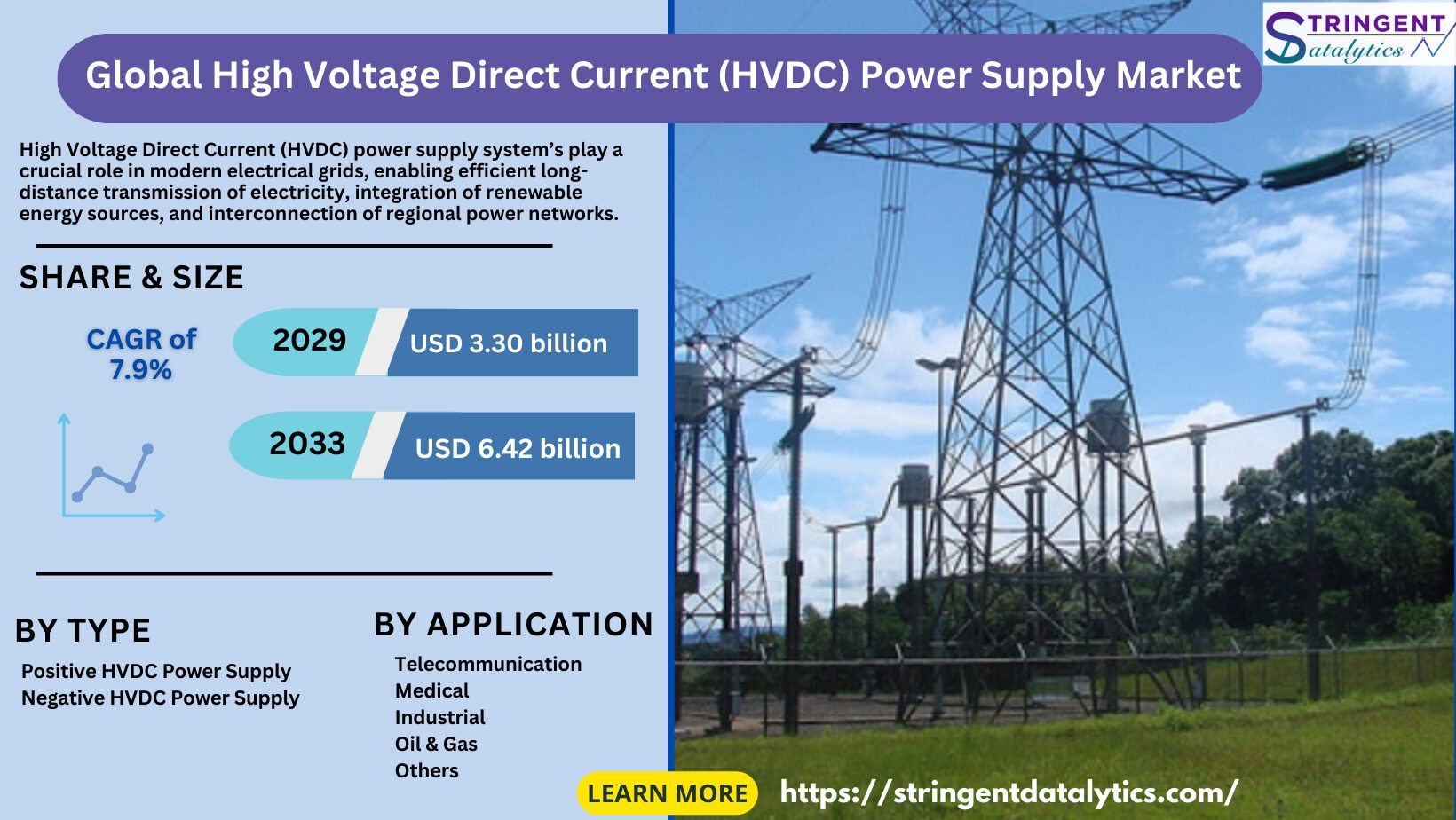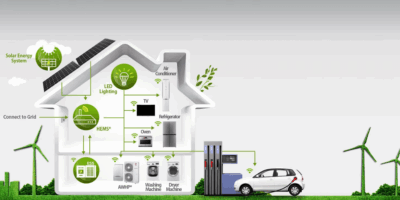The global High Voltage Direct Current (HVDC) Power Supply Market was valued from USD 3.30 billion in 2023 to USD 6.42 billion in 2033 and is anticipated to exhibit a CAGR of 7.9% from 2024 to 2033.
Introduction
The High Voltage Direct Current (HVDC) power supply market is pivotal in the modern energy landscape, offering efficient solutions for long-distance power transmission and integration of renewable energy sources. HVDC technology is essential for addressing the growing energy demands, improving grid stability, and facilitating the global transition towards sustainable energy systems. This article provides a comprehensive overview of the HVDC power supply market, including its current trends, market size, growth drivers, challenges, and future opportunities.
Market Overview
HVDC Power Supply Trends
The HVDC power supply market is experiencing significant growth, driven by several key trends. One of the most prominent trends is the increasing adoption of HVDC technology for long-distance and submarine power transmission. HVDC systems are preferred over traditional AC systems for these applications due to their lower transmission losses and higher efficiency over long distances.
Another trend is the integration of renewable energy sources such as wind and solar power into the grid. HVDC technology is particularly suitable for connecting remote renewable energy generation sites to the main grid, facilitating the transport of large amounts of power over long distances with minimal losses.
Additionally, advancements in HVDC converter technologies, such as Voltage Source Converters (VSC) and Modular Multilevel Converters (MMC), are enhancing the performance and reliability of HVDC systems. These innovations are expanding the range of applications and improving the feasibility of HVDC projects.
Global HVDC Power Supply Industry
The global HVDC power supply industry is marked by robust growth and regional diversification. Europe and Asia-Pacific are leading regions in terms of HVDC project deployment and technological advancements. Europe, in particular, is at the forefront of HVDC adoption, driven by the need to integrate offshore wind farms and enhance cross-border electricity trade.
Asia-Pacific, with countries like China and India, is also witnessing significant growth in the HVDC market. The region’s rapid industrialization, urbanization, and increasing energy consumption are driving the demand for efficient power transmission solutions. China, in particular, has been a major player in HVDC technology, with numerous large-scale HVDC projects in operation and under development.
North America is another key market, characterized by efforts to modernize the aging power infrastructure and integrate renewable energy sources. The United States and Canada are investing in HVDC projects to improve grid reliability and facilitate the transition to a sustainable energy future.
HVDC Power Supply Market Size
As of 2024, the global HVDC power supply market is estimated to be worth approximately USD 10 billion. The market has shown impressive growth over the past few years, with a compound annual growth rate (CAGR) of around 7%. This growth is driven by the increasing need for efficient power transmission solutions, rising investments in renewable energy projects, and technological advancements in HVDC systems.
Projections suggest that the market will continue to expand, reaching an estimated USD 15 billion by 2030. The ongoing development of HVDC infrastructure, coupled with supportive government policies and funding for energy projects, will contribute to this growth.
HVDC Power Supply Market Forecast
The future of the HVDC power supply market looks promising, with several factors contributing to its positive outlook. The global push for renewable energy integration and the need for reliable, efficient power transmission systems will drive the demand for HVDC technology. Additionally, technological advancements in HVDC components, such as converters, cables, and control systems, will enhance the performance and cost-effectiveness of HVDC projects.
Moreover, the increasing interconnection of regional power grids and the development of supergrids will create new opportunities for the HVDC market. Supergrids, which are large-scale electrical grids that span multiple countries or continents, rely on HVDC technology to efficiently transmit power over long distances and across different grid systems.
HVDC Power Supply Market Growth
The growth trajectory of the HVDC power supply market is underpinned by several key factors. The global energy transition towards cleaner and more sustainable sources is a major driver. HVDC technology enables the efficient integration of renewable energy sources, such as offshore wind farms and solar power plants, into the grid. This capability is crucial for meeting the increasing energy demand while reducing greenhouse gas emissions.
Another important growth factor is the modernization of aging power infrastructure. Many countries are investing in upgrading their power grids to improve reliability, reduce transmission losses, and enhance grid stability. HVDC technology is an essential component of these modernization efforts, providing a cost-effective and efficient solution for long-distance power transmission.
Regional HVDC Power Supply Markets
Regional variations in the HVDC power supply market are pronounced. Europe is a leader in HVDC technology adoption, driven by the need to integrate large-scale offshore wind farms and enhance cross-border electricity trade. The European Union’s ambitious renewable energy targets and supportive regulatory framework are fostering the growth of the HVDC market in the region.
Asia-Pacific is another significant market, with China and India leading the way. China’s rapid industrialization and urbanization, coupled with its commitment to renewable energy development, have resulted in numerous large-scale HVDC projects. India is also investing in HVDC technology to address its growing energy demand and improve grid reliability.
North America is witnessing steady growth in the HVDC market, driven by efforts to modernize the power infrastructure and integrate renewable energy sources. The United States and Canada are focusing on HVDC projects to enhance grid reliability, reduce transmission losses, and support the transition to a sustainable energy future.
HVDC Power Supply Market Dynamics
Understanding the dynamics of the HVDC power supply market requires examining both demand and supply factors. On the demand side, the increasing need for efficient and reliable power transmission solutions is a major driver. HVDC technology offers significant advantages over traditional AC systems, including lower transmission losses, higher efficiency, and the ability to transmit power over long distances and across different grid systems.
On the supply side, factors such as technological advancements, production costs, and regulatory standards play critical roles. The market dynamics are also influenced by the competitive landscape, with numerous players vying for market share through innovation, quality, and pricing strategies.
Receive the FREE Sample Report of High Voltage Direct Current (HVDC) Power Supply Market Research Insights @ https://stringentdatalytics.com/sample-request/high-voltage-direct-current-(hvdc)-power-supply-market/15028/
Market Segmentations:
Global High Voltage Direct Current (HVDC) Power Supply Market: By Company
ABB
AHV
American Power Design
Applied Kilovolts
Excelitas Technologies
General Electric
Glassman Europe
Hamamatsu
Hi-Tek Power
HVM Technology
Matsusada Precision
Nippon Telegraph and Telephone
Pico Electronics
Siemens
Spellman High Voltage Electronics
Toshiba
UltraVolt
XP Power
Global High Voltage Direct Current (HVDC) Power Supply Market: By Type
Positive Polarity High Voltage Direct Current(HVDC) Power Supply
Negative Polarity High Voltage Direct Current(HVDC) Power Supply
Global High Voltage Direct Current (HVDC) Power Supply Market: By Application
Telecommunication
Medical
Industrial
Oil & Gas
Others
Regional Analysis of Global High Voltage Direct Current (HVDC) Power Supply Market
All the regional segmentation has been studied based on recent and future trends, and the market is forecasted throughout the prediction period. The countries covered in the regional analysis of the Global High Voltage Direct Current (HVDC) Power Supply market report are U.S., Canada, and Mexico in North America, Germany, France, U.K., Russia, Italy, Spain, Turkey, Netherlands, Switzerland, Belgium, and Rest of Europe in Europe, Singapore, Malaysia, Australia, Thailand, Indonesia, Philippines, China, Japan, India, South Korea, Rest of Asia-Pacific (APAC) in the Asia-Pacific (APAC), Saudi Arabia, U.A.E, South Africa, Egypt, Israel, Rest of Middle East and Africa (MEA) as a part of Middle East and Africa (MEA), and Argentina, Brazil, and Rest of South America as part of South America.
Click to Purchase High Voltage Direct Current (HVDC) Power Supply Market Research Report @ https://stringentdatalytics.com/purchase/high-voltage-direct-current-(hvdc)-power-supply-market/15028/?license=single
Introduction
The High Voltage Direct Current (HVDC) power supply market is pivotal in the modern energy landscape, offering efficient solutions for long-distance power transmission and integration of renewable energy sources. HVDC technology is essential for addressing the growing energy demands, improving grid stability, and facilitating the global transition towards sustainable energy systems. This article provides a comprehensive overview of the HVDC power supply market, including its current trends, market size, growth drivers, challenges, and future opportunities.
Market Overview
HVDC Power Supply Trends
The HVDC power supply market is experiencing significant growth, driven by several key trends. One of the most prominent trends is the increasing adoption of HVDC technology for long-distance and submarine power transmission. HVDC systems are preferred over traditional AC systems for these applications due to their lower transmission losses and higher efficiency over long distances.
Another trend is the integration of renewable energy sources such as wind and solar power into the grid. HVDC technology is particularly suitable for connecting remote renewable energy generation sites to the main grid, facilitating the transport of large amounts of power over long distances with minimal losses.
Additionally, advancements in HVDC converter technologies, such as Voltage Source Converters (VSC) and Modular Multilevel Converters (MMC), are enhancing the performance and reliability of HVDC systems. These innovations are expanding the range of applications and improving the feasibility of HVDC projects.
Global HVDC Power Supply Industry
The global HVDC power supply industry is marked by robust growth and regional diversification. Europe and Asia-Pacific are leading regions in terms of HVDC project deployment and technological advancements. Europe, in particular, is at the forefront of HVDC adoption, driven by the need to integrate offshore wind farms and enhance cross-border electricity trade.
Asia-Pacific, with countries like China and India, is also witnessing significant growth in the HVDC market. The region’s rapid industrialization, urbanization, and increasing energy consumption are driving the demand for efficient power transmission solutions. China, in particular, has been a major player in HVDC technology, with numerous large-scale HVDC projects in operation and under development.
North America is another key market, characterized by efforts to modernize the aging power infrastructure and integrate renewable energy sources. The United States and Canada are investing in HVDC projects to improve grid reliability and facilitate the transition to a sustainable energy future.
HVDC Power Supply Market Size
As of 2024, the global HVDC power supply market is estimated to be worth approximately USD 10 billion. The market has shown impressive growth over the past few years, with a compound annual growth rate (CAGR) of around 7%. This growth is driven by the increasing need for efficient power transmission solutions, rising investments in renewable energy projects, and technological advancements in HVDC systems.
Projections suggest that the market will continue to expand, reaching an estimated USD 15 billion by 2030. The ongoing development of HVDC infrastructure, coupled with supportive government policies and funding for energy projects, will contribute to this growth.
HVDC Power Supply Market Forecast
The future of the HVDC power supply market looks promising, with several factors contributing to its positive outlook. The global push for renewable energy integration and the need for reliable, efficient power transmission systems will drive the demand for HVDC technology. Additionally, technological advancements in HVDC components, such as converters, cables, and control systems, will enhance the performance and cost-effectiveness of HVDC projects.
Moreover, the increasing interconnection of regional power grids and the development of supergrids will create new opportunities for the HVDC market. Supergrids, which are large-scale electrical grids that span multiple countries or continents, rely on HVDC technology to efficiently transmit power over long distances and across different grid systems.
HVDC Power Supply Market Growth
The growth trajectory of the HVDC power supply market is underpinned by several key factors. The global energy transition towards cleaner and more sustainable sources is a major driver. HVDC technology enables the efficient integration of renewable energy sources, such as offshore wind farms and solar power plants, into the grid. This capability is crucial for meeting the increasing energy demand while reducing greenhouse gas emissions.
Another important growth factor is the modernization of aging power infrastructure. Many countries are investing in upgrading their power grids to improve reliability, reduce transmission losses, and enhance grid stability. HVDC technology is an essential component of these modernization efforts, providing a cost-effective and efficient solution for long-distance power transmission.
HVDC Power Supply Market Dynamics
Understanding the dynamics of the HVDC power supply market requires examining both demand and supply factors. On the demand side, the increasing need for efficient and reliable power transmission solutions is a major driver. HVDC technology offers significant advantages over traditional AC systems, including lower transmission losses, higher efficiency, and the ability to transmit power over long distances and across different grid systems.
On the supply side, factors such as technological advancements, production costs, and regulatory standards play critical roles. The market dynamics are also influenced by the competitive landscape, with numerous players vying for market share through innovation, quality, and pricing strategies.
Market Drivers
Renewable Energy Integration
The integration of renewable energy sources is a major driver of the HVDC power supply market. As countries around the world strive to reduce their carbon emissions and transition to cleaner energy sources, the demand for HVDC technology is increasing. HVDC systems enable the efficient transmission of power generated from renewable sources, such as offshore wind farms and solar power plants, to the main grid.
Modernization of Power Infrastructure
The modernization of aging power infrastructure is another key driver of the HVDC market. Many countries are investing in upgrading their power grids to improve reliability, reduce transmission losses, and enhance grid stability. HVDC technology plays a crucial role in these modernization efforts, providing a cost-effective and efficient solution for long-distance power transmission.
Technological Advancements
Technological advancements in HVDC components, such as converters, cables, and control systems, are driving the growth of the HVDC market. Innovations in HVDC converter technologies, such as Voltage Source Converters (VSC) and Modular Multilevel Converters (MMC), are enhancing the performance and reliability of HVDC systems. These advancements are expanding the range of applications and improving the feasibility of HVDC projects.
Government Policies and Funding
Supportive government policies and funding for energy projects are also contributing to the growth of the HVDC market. Many governments are implementing policies to promote the development and deployment of HVDC technology, including funding for research and development, subsidies for HVDC projects, and regulatory incentives for renewable energy integration. These policies are creating a favorable environment for the growth of the HVDC market.
Increasing Energy Demand
The increasing global energy demand is another driver of the HVDC market. As the world’s population grows and economies expand, the demand for electricity is rising. HVDC technology provides a reliable and efficient solution for meeting this growing energy demand, enabling the transmission of large amounts of power over long distances with minimal losses.
Market Challenges
High Initial Costs
One of the main challenges facing the HVDC market is the high initial cost of HVDC projects. The installation and commissioning of HVDC systems require significant investments in infrastructure, equipment, and technology. This can be a barrier for some countries and regions, particularly those with limited financial resources.
Technological Complexity
The technological complexity of HVDC systems is another challenge. HVDC technology involves advanced components and sophisticated control systems, which require specialized knowledge and expertise to design, install, and maintain. This can be a barrier for some utilities and grid operators, particularly those with limited experience with HVDC technology.
Regulatory and Environmental Concerns
Regulatory and environmental concerns can also pose challenges for the HVDC market. The development and deployment of HVDC projects are subject to regulatory approval and environmental impact assessments, which can be time-consuming and costly. Additionally, there can be public opposition to HVDC projects due to concerns about the visual impact of overhead transmission lines and potential environmental impacts.
About Stringent Datalytics
Stringent Datalytics offers both custom and syndicated market research reports. Custom market research reports are tailored to a specific client’s needs and requirements. These reports provide unique insights into a particular industry or market segment and can help businesses make informed decisions about their strategies and operations.
Syndicated market research reports, on the other hand, are pre-existing reports that are available for purchase by multiple clients. These reports are often produced on a regular basis, such as annually or quarterly, and cover a broad range of industries and market segments. Syndicated reports provide clients with insights into industry trends, market sizes, and competitive landscapes. By offering both custom and syndicated reports, Stringent Datalytics can provide clients with a range of market research solutions that can be customized to their specific needs.
Reach US
Stringent Datalytics
+1 346 666 6655
Social Channels:




Leave a Reply